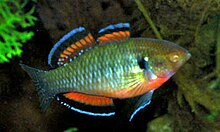Hypseleotris compressa
| Hypseleotris compressa | |
|---|---|

| |
| Scientific classification | |
| Kingdom: | |
| Phylum: | |
| Class: | |
| Order: | |
| Family: | |
| Genus: | |
| Species: | H. compressa
|
| Binomial name | |
| Hypseleotris compressa | |
| Synonyms | |
|
Eleotris compressus Krefft, 1864[1] | |
Hypseleotris compressa (commonly known as the empire gudgeon) is a species of gudgeon endemic to Australia and Papua New Guinea. It can be up to 12 centimetres (4.7 in) long, the males being larger than the females. The fish has omnivorous feeding habits. During the breeding season, the male's color becomes much brighter than usual, which is used to attract a mate. When the fish spawns during the warm part of the year, up to 3,000 eggs are laid by the female. Their eggs hatch after 10–14 days.
Location and habitat
The Hypseleotris compressa population is mostly concentrated in the northern and eastern portions of Australia[3] and southern Papua New Guinea.[4] It has also been found in the Torres Strait, around Muralag and Horn Island.[5]
The fish is most commonly found in freshwater flowing rivers or streams,[3][5] but is also found in still water.[3][4] It is usually found in the lower reaches of rivers, but can also live upstream.[3][5] It swims amongst aquatic plants and branches,[4][6] and sometimes hides among rocks, using them as "caves".[3]
Description
Hypseleotris compressa has an elongate body which can be up to 12 centimetres (4.7 in) long.[3] The males are larger than the females.[6] The fish does not have a lateral line. It has ctenoid scales.[5]
Its color varies, but the fish generally has a yellowish-tan to golden-brown head, although it can occasionally be a dark brown.[3] Its abdomen is usually a whitish-red color.[3][7] During the off-breeding seasons, males can be identified by prominent variously colored bands on their anal and dorsal fins. The caudal fin is a "dusky" color, and the pectoral and pelvic fins have no color.[3] During the breeding season, the male's colors brighten significantly, turning a red-orange color, and it sometimes appears to glow.[3][7] The male fish uses its colors to attract a mate.[4] The species can quickly change its shade of color if needed.[3]
The fish is omnivorous, consuming small crustaceans and insects, insect larvae, algae, and aquatic plants.[5][6]
Spawning usually occurs in freshwater during warm weather; the breeding season generally spans from spring to autumn. After spawning with the male, the female fish lays rows of adhesive eggs totaling about 3,000 eggs. The eggs stick to various surfaces, such as plants, logs, rocks, or sand. The male then fertilizes the eggs with "sperm lines". The male guards the eggs until the young fish hatch, which usually takes 10–14 days. After hatching, the young fish go downstream to estuaries, where their development takes place. Once grown, the fish returns to freshwater.[3][4][5]
References
- ^ a b Froese, Rainer; Pauly, Daniel (eds.) (2014). "Hypseleotris compressa" in FishBase. November 2014 version.
- ^ "Hypseleotris compressa (Krefft, 1864)". GBIF.org. Retrieved 18 February 2015.
- ^ a b c d e f g h i j k l "Action Statement: Flora and Fauna Guarantee Act 1988" (PDF). depi.vic.gov.au. Retrieved 12 February 2015.
- ^ a b c d e "Comprehensive Description". eol.org. Retrieved 12 February 2015.
- ^ a b c d e f "Empire Gudgeon, Hypseleotris compressa (Krefft 1864)". fishesofaustralia.net.au. Retrieved 12 February 2015.
- ^ a b c "Hypseleotris compressa". www-public.jcu.edu.au. Retrieved 12 February 2015.
- ^ a b "Empire Gudgeon, Hypseleotris compressa (Krefft, 1864)". australianmuseum.net.au. Retrieved 16 February 2015.
